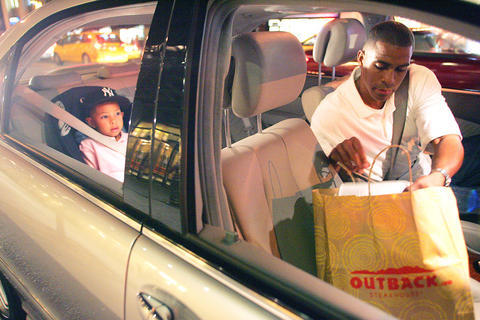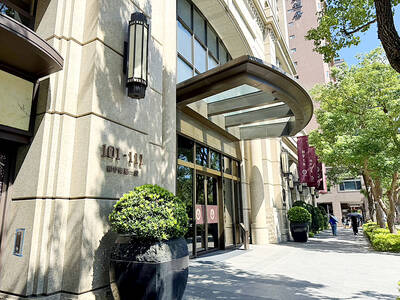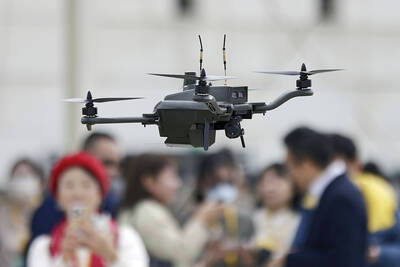Who has never been put on hold while trying to order pizza, hot wings or moo shu pork? Who has never opened a delivery bag and discovered a Coke instead of a Diet Coke, or that the brown rice is as white as the napkins the restaurant neglected to include?
"I hate calling up to order food," said Lewis Friedman, a Manhattan real estate broker. "It throws me over the edge. They put you on hold. They get the order wrong. It's always a crapshoot."
But all that changed last month when he saw a sign in the window of Lenny's, a chain of sandwich shops in Manhattan, encouraging customers to place orders online. Friedman returned to his office, logged on and, at long last, felt in control of his gustatory future.

PHOTO: NY TIMES NEWS SERVICE
"I'm in the driver's seat," he said. "I can click that I like light skim milk. I can click for Equal as opposed to Sweet'n Low or Splenda."
The comedian Jim Gaffigan has teased Americans about how fast they want their food. "That's why we really love those value meals," he said. "You just have to say a number: `Two!' Soon you won't have to speak. It will just be a noise. `Ennnghhh!'"
Gaffigan must have a crystal ball. Small and large chains, even individual restaurants, are now enabling customers to order without speaking: They can order online before pulling into a drive-through; they can text-message an order; and soon, they will be able to experience one-click ordering on their cell phones, for pickup or delivery. Push a button, and a hoagie is on the way.
The restaurant industry is investing in such technology to woo the thousands of consumers like Friedman who fly through life with their thumbs on their BlackBerrys. Hoping to make ordering a burger as routine as ordering a book from Amazon, a number of chains are emphasizing the dot-com after their corporate name to lure the hungry and time-pressed to their Web sites.
As for all those supposed concerns about unhealthy eating and the retreat from home cooking -- who are we fooling? The average American 18 and older buys a snack or a meal from a restaurant five times a week on average, according to a 2006 survey by the National Restaurant Association. More people eat at their desks and in their cars. And children are weaned on drive-through, pickup and delivery.
The biggest regret Americans seem to have about fast food is that it isn't snappier: A survey last year by QSR magazine, a restaurant industry publication, found that 68 percent of people are willing to wait no more than five minutes in a drive-through line. And in an age where everything from sneakers to cars is customizable, people think they should be able to get exactly what they want, when they want it.
"It has really, really exploded in the past year or two," said Patrick Doyle, the executive vice president of Team USA, the name Domino's Pizza uses for its corporately owned locations. "I predict pizza will be one of the top 10 items purchased online within the next 12 to 24 months."
Though online ordering has been around at some locations for about five years, most people still call in or wait in lines to place their orders. About 13 percent of Americans placed online food orders from a restaurant last year, according to the National Restaurant Association, up from about 10 percent in 2004.
But Philip DeSorbo Jr., a project leader for the retail technology department at Subway, which has nearly 28,000 restaurants in 87 countries, said these days many people would rather send an e-mail message than leave a voice-mail message. "I think online will eventually surpass picking up the phone," he said.
Igniting the trend are consumers like Friedman, who may seem like the finicky protagonist of Dr. Seuss' Green Eggs and Ham, but who is just your average multitasking, high-speed American.
Now each weekday morning he places an online order with Lenny's. Soon an iced coffee and an Atkin's Special (egg whites, turkey, onion, tomato, roasted red pepper) are made to his typed specifications and delivered to the reception desk.
"I'm saving time," said Friedman, who orders breakfast and lunch online. "I'm so adept at it now that I can actually do business on the phone while I'm placing my food order."
People like him see advantages to online and text ordering. It is faster; there is no being placed on hold or inadvertently hung up on; and you need not ask about the specials or explain that the jalapenos should be on the side. It is more accurate; you type in the order and delivery address yourself. There is no need for cash. Favorite orders and credit card information can be saved so reordering is a matter of a few mouse clicks. A delivery can be scheduled days in advance. And thanks to electronic menus, there is more drawer space in the kitchen.
About three months ago, an Outback Steakhouse on West 23rd Street in Manhattan began offering curbside take away, said Chris Eldridge, the proprietor. Customers place an order online and type in the make and color of their car. When they pull up to the restaurant, their food is carried out to them.
Industry executives have found that those inclined to use online or text ordering are less defined by race or age than by whether or not they have access to high-speed Internet connections. Online orders on corporate Web sites or sites like SeamlessWeb.com, an aggregate site for restaurant ordering, come from working parents in search of no-fuss family dinners, ravenous college students and professionals working overtime.
For that reason, perhaps no group understands the benefits of new ordering methods better than college students, who grew up zooming through cyberspace. In response to student demand for a way to text food orders to restaurants in between classes, Campusfood.com, an online network of restaurants available on more than 300 campuses, began offering text and SMS message ordering in April. The first big push for the service will be this fall.
"It's exactly like sending a regular text message like I do with my friends all the time," said Rebecca Minsky, 21, a junior at Cornell University who has been using Campusfood.com since her freshman year. When she leaves the gym she texts her order; by the time she arrives home, dinner is ready.
In fact, Minsky used Campusfood.com so often that she ended up interning for them this summer.

FOUR DESIGNATED AREAS: Notices were issued for live-fire exercises in waters south and northwest of Penghu, northeast of Keelung and west of Kaohsiung, they said The military is planning three major annual exercises across the army, navy and air force this month, with the navy’s “Hai Chiang” (海強, “Sea Strong”) drills running from today through Friday, the Ministry of National Defense said yesterday. The Hai Chiang exercise, which is to take place in waters surrounding Taiwan, would feature P-3C Orion maritime patrol aircraft and S-70C anti-submarine helicopters, the ministry said, adding that the drills aim to bolster the nation’s offshore defensive capabilities. China has intensified military and psychological pressure against Taiwan, repeatedly sending warplanes and vessels into areas near the nation’s air defense identification zone and across

FORCED LABOR: A US court listed three Taiwanese and nine firms based in Taiwan in its indictment, with eight of the companies registered at the same address Nine companies registered in Taiwan, as well as three Taiwanese, on Tuesday were named by the US Department of the Treasury’s Office of Foreign Assets Control (OFAC) as Specially Designated Nationals (SDNs) as a result of a US federal court indictment. The indictment unsealed at the federal court in Brooklyn, New York, said that Chen Zhi (陳志), a dual Cambodian-British national, is being indicted for fraud conspiracy, money laundering and overseeing Prince Holding Group’s forced-labor scam camps in Cambodia. At its peak, the company allegedly made US$30 million per day, court documents showed. The US government has seized Chen’s noncustodial wallet, which contains

SUPPLY CHAIN: Taiwan’s advantages in the drone industry include rapid production capacity that is independent of Chinese-made parts, the economic ministry said The Executive Yuan yesterday approved plans to invest NT$44.2 billion (US$1.44 billion) into domestic production of uncrewed aerial vehicles over the next six years, bringing Taiwan’s output value to more than NT$40 billion by 2030 and making the nation Asia’s democratic hub for the drone supply chain. The proposed budget has NT$33.8 billion in new allocations and NT$10.43 billion in existing funds, the Ministry of Economic Affairs said. Under the new development program, the public sector would purchase nearly 100,000 drones, of which 50,898 would be for civil and government use, while 48,750 would be for national defense, it said. The Ministry of

SENATE RECOMMENDATION: The National Defense Authorization Act encourages the US secretary of defense to invite Taiwan’s navy to participate in the exercises in Hawaii The US Senate on Thursday last week passed the National Defense Authorization Act (NDAA) for Fiscal Year 2026, which strongly encourages the US secretary of defense to invite Taiwan’s naval forces to participate in the Rim of the Pacific (RIMPAC) exercise, as well as allocating military aid of US$1 billion for Taiwan. The bill, which authorizes appropriations for the military activities of the US Department of Defense, military construction and other purposes, passed with 77 votes in support and 20 against. While the NDAA authorizes about US$925 billion of defense spending, the Central News Agency yesterday reported that an aide of US